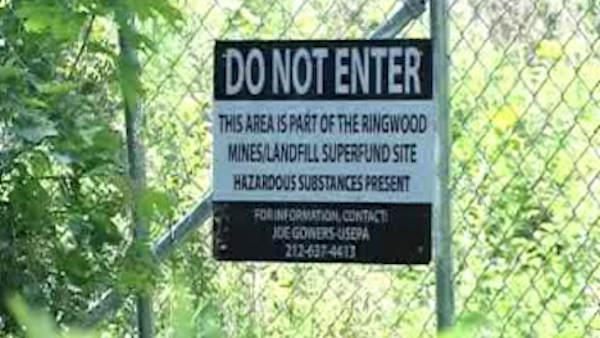 |
| Upper Ringwood Superfund Site |
Upper Ringwood, New Jersey continues facing the long-term consequences of hazardous waste dumping. According to the ABC news affiliate WABC in New York City, the most recent evidence comes with “chemicals seeping into the water and food” supplies.
Those chemicals come from an on again, and off again, Superfund site within a few yards of where children play today, and where children a generation before them played. The contaminants include lead, arsenic, cadmium and benzene, and the sources could very well be from a long list of polluters, beginning with the now-closed mines at the nearby Ramapo Mountains. Now, the federal and state governments are encouraging all children under six years old to be tested for elevated lead levels.
The small community sports a mix of the three races with a large concentration of Native Americans from the Ramapough Mountain Indian Tribe, all of which drew a living from the mining activities. As an iron ore “mine town” the residents didn’t own their homes, but instead leased them from the mine owners; a situation that lasted from the early 1900s to the early 1950s when the mines closed. That same decade, Ford Motor Company purchased the land from the mining company and continued the lease/tenant relationships with the residents. Ford also built and started operations at its Mahwah assembly plant in nearby Mahwah during the mid 1950s, and, that’s where the Superfund debacle began.
Ford claimed that with the permission of local authorities it began dumping waste at Upper Ringwood and did so for four years. The waste included auto parts, cardboard, packing materials, scrap, dented drums with hardened production sealing and insulating stock... and paint sludge, according to a detailed article in the New York Times. The EPA claimed in 2007 that Ford dumped thousands of tons of paint sludge, and residents remember trash everywhere including drums of chemicals, and dumpsters that would “mysteriously burn for weeks.” Then in 1982 state regulators discovered elevated levels of arsenic in drinking water supplies.
In 1983 the area was designated a Superfund site and Ford undertook the cleanup. But, for many reasons, including the fact this was one of the very early efforts under the Superfund program and the learning curve was steep, the cleanup didn’t come out well. Even though it was closed out as a Superfund site in 1994, it was reopened in 2006. By 2007 crews had collected an additional several thousand tons of waste and discovered paint sludge in the yards of two residences. As late as 2009, the New York Times reported that Ford was in its fifth cleanup at the site and had removed another 35,000 tons of toxic materials.
It was in 2005 that residents began wondering about a long list of physical ailments including skin rashes, nose bleeds, bronchitis, people needing amputations, cancers, extended illnesses and deaths. Unable to chalk it up to bad luck, a group of 600 residents sued Ford and others in 2006. The suit was settled in 2009 with residents and lawyers receiving an estimated $10 million while the defendants never admitted any wrongdoing. No doubt though, this story is far from over.

2 comments:
Saw the HBO movie on it last night. Interesting to see the differences from the Erin Brockovitch story. Unlike PG&E, Ford simply threatened bankruptcy which is believable in this economy and the troubles Chrysler and Government Motors has had. With this threat, the plaintiffs only got about $8000 on average. Sad.
But in Fords defense, there are still a lot of unanswered questions regarding the original mine. How much of the communities problems stem from the mine itself. I feel confident that Ford added to the delimna by what was determined to be legal dumping at the time (legal but not necessarily ethical, not knowing if the knowledge of the ramifications were truely known then) but how do you separate the liability of Ford from background conditions?
Posted by Lee Gerald
What's strange is that these companies and States continue to find ways to dump their crap in other places. For example, The New Jersey Zinc Company, once located in Palmerton PA which no longer exists is a superfund site. Recently purchased by an investment firm which has come in and knocked down all the old Zinc Company buildings. They are bringing fill in daily from Jersey. The fill is contaminated by Jersey standards but not by PA standards. Sorry, but, um, a bird is a bird, no matter how you look at it bigger smaller, red, brown, it's still a bird. The bad part is, that this crap is being dumped next to a stream that leads to a major river. Oh, well, it's just the lives of other people. Money means more I guess.
Post a Comment